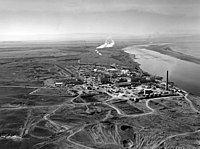
Photo from wikipedia
Biogeochemical redox processes control the chemical behavior of many major and trace elements, making their comprehension crucial for predicting and protecting environmental health. Nitrogen is especially susceptible to changes in… Click to show full abstract
Biogeochemical redox processes control the chemical behavior of many major and trace elements, making their comprehension crucial for predicting and protecting environmental health. Nitrogen is especially susceptible to changes in soil redox conditions and affects the cycles of other redox-sensitive species. Elevated nitrogen concentrations, in nitrate form, in agricultural soils and associated freshwater ecosystems constitute a problem in many parts of the world. Although a wide variety of measures have already been adopted, their assessment through concentration measurements in groundwater and surface water of the different monitoring networks has shortcomings. Nitrate, as a non-point pollutant, is subject to several processes, such as transformation and retardation, before it is detected, making it impossible to evaluate measurements' effectiveness reliably. Thus, we designed and constructed a monitoring station featuring commercially-available products and self-manufactured components at an agricultural site for the in-situ assessment of nitrate-related processes by high-resolution monitoring of hydraulic (soil water content, matric potential, groundwater head) and hydrogeochemical variables (oxidation-reduction potential, ground-, and pore water chemistry) within the vadose zone and the shallow aquifer. The monitoring station has proven to be a reliable tool. Changes over depth and time of measured variables have been identified, allowing the detection of the transient behavior of the redox reactive zone, the interpretation of ongoing denitrification processes, and other redox nitrate-triggered phenomena such as uranium roll-front and selenium accumulation at the redox interface. Measuring both geochemical and soil water variables allows for the calculation of in-situ solute inputs into the groundwater and their reaction rates. This article is protected by copyright. All rights reserved.
Journal Title: Journal of environmental quality
Year Published: 2022
Link to full text (if available)
Share on Social Media: Sign Up to like & get
recommendations!